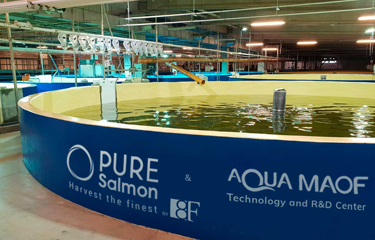Singapore-based Pure Salmon has picked Lesotho, the mountainous landlocked kingdom encircled by South Africa, as its preferred location for one of nine global land-based recirculating aquaculture system (RAS) facilities the company hopes to open to achieve an annual production of 260,000 tons of salmon by 2025.
The project will be Africa’s first RAS salmon farm, said Stephane Farouze, Pure Salmon board director and founder of BF Asset Management – Pure Salmon’s parent company – in an interview with CNBC Africa.
“Lesotho was for us a place in Africa to be chosen. We were looking at different places but we had to find a place with clean water and clean energy and at a very good price, and this is very difficult to find in Africa,” Farouze said.
Farouze said the USD 250 million (EUR 224.3 million) Atlantic salmon facility will be located at Butha-Buthe highland region and will be developed in partnership with state-owned Lesotho National Development Corporation (LNDC). The farm will have capacity to produce 20,000 metric tons of salmon per year when fully completed in 2023.
Pure Salmon has developed a similar plant in Poland and is working on one each in Japan, France, and the United States – and five more in China – a strategy the company said assures it of at least 140,000 tons of production annually of its envisaged 260,000 tons per year.
Lesotho government officials resolved to work with Pure Salmon after they visited the company’s facility in Poland where “they loved the technology and for them it was important for the country,” Farouze told CNBC.
Because of the availability of clean water sources in Lesotho, Farouze said salmon that will be produced from this landlocked country “will be free of antibiotics, pesticides, hormones and microplastics.”
“We are taking eggs off wild salmon and grow our fish in completely safe environments which we can guarantee that our fish has no antiobiotics, chemicals or microplastics,” Farouze said.
It is projected the new Pure Salmon project in Lesotho will generate USD 200 million (EUR 179.4 million) annually and create at least 250 jobs in addition to contributing between 8 percent and 10 percent to the country’s gross domestic product.
Although the potential for Lesotho’s fisheries and aquaculture has been growing based on governmental water development initiatives, such as the Lesotho Highlands Water Project, the country’s capture fisheries production was only 390 tons in 2016, while aquaculture production was 1,300 tons for the same year, the most recent for which data is available.
Currently, Lesotho, with an estimated fish per capita consumption of 0.8 kilograms, has two distinct fish farming zones – the Lowlands, with relatively high temperatures, and the Highlands, characterized by colder, mountainous conditions.
“The cold climatic conditions in Lesotho are suitable for production of high-quality trout, (which), like its salmon cousins, requires clean and cold, well-oxygenated, fast-moving water at a high altitude, which is exactly what Lesotho’s dam reservoirs offer,” according to the SADC report. “Lesotho has an abundance of fresh disease-free water and fish farming has emerged as a lucrative business activity with two farms supplying the Republic of South Africa and Japan with trout/salmon.”
Moreover, SADC said Lesotho’s current capacity “services a very small fraction of the market, leaving very big room for investment in expansion and diversification of fish species for these markets which allow for duty free-quota free entry of fish from Lesotho.”
Photo courtesy of Pure Salmon







